2010
Graduation 2010
20 December 2010
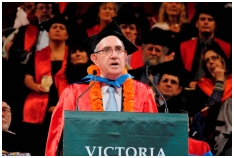
Prof Sir Paul Callaghan received his Honorary Doctorate at the December graduation ceremony. In his speech, he recounted four stories from his life and drew the following lessons:
- Never worry about the things you are no good at. Discover what you are good at and do that, and do it with commitment. But always respect those whose talents are different from your own.
- See the opportunities in new directions. "If you do not change direction, you may end up where you are heading," Lao Tze, Chinese philosopher.
- Never underestimate the capacity of those younger than you to surprise you with their talent. Learn from them, and always revel in the opportunity to combine talents to build a team.
- Live each day as if it were your last, and at the same time, live as though you will live forever — this is paradox. And what really counts in life is love.
He finished by saying, "you are at a waypoint on your life's journey. Make every step count."
Callaghan group wins Prime Minister's Science Prize
26 November 2010
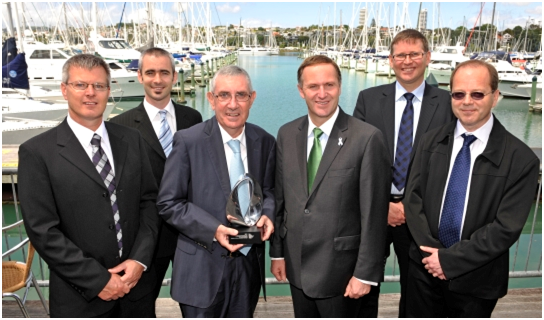
The 2010 Prime Minister's Science Prize has been awarded to the Magnetic Resonance Innovation team that is led by Professor Sir Paul Callaghan. The team includes four of his former PhD students who have gone on to become internationally respected scientists in their fields. The team is:
- Professor Paul Callaghan, Professor in the School of Chemical and Physical Sciences
- Dr Robin Dykstra, Senior Lecturer in the School of Engineering and Computer Science
- Dr Mark Hunter, Research Fellow in the School of Chemical and Physical Sciences
- Dr Andrew Coy, a physicist and Chief Executive Officer of Wellington technology company Magritek
- Dr Craig Eccles, a physicist and Chief Technology Officer at Magritek.
The Prime Minister's Science Prize combines recognition and reward, with the winning team receiving $500,000 of which $400,000 is earmarked for ongoing research. The prize is awarded for a transformative science discovery or achievement which has had an impact on New Zealand or internationally.
Research from the Magnetic Resonance Innovation Team has been used in medical magnetic resonance imaging (MRI) and in climate change research in Antarctica, and the team is looking to apply its research in agriculture and industry.
In 2004, technology company Magritek was formed by Victoria and Massey universities and the five scientists. Magritek is growing fast. It now has more than 15 employees and has increased revenue by 50 per cent in each of the five years it has been operating, through international sales.
Professor Callaghan says the team formed Magritek because it wanted New Zealand to benefit from its work: "We'd proved that you could stay in New Zealand and be world-class scientists but where was the value to the economy in what we were doing? The next logical step was to show that you can produce excellent science while also being business savvy."
The MR Innovation team plans to use the $400,000 of prize money tagged for ongoing development of its technology to establish a PhD scholarship to allow exceptional New Zealand graduates to undertake research in the field of magnetic resonance science or engineering.
Professor Callaghan has received many honours and awards during his career, but says he is especially proud to have been awarded the Prime Minister's Science Prize.
"It's a wonderful thing to be recognised by your own country and to have your work seen as valuable. But the most exciting thing is that this prize goes to the whole team. We are different ages and bring different skills but all have been captivated by this area of research which not only has enormous applicability in industry, medicine and environmental science, but is also just beautiful science.
"The thrill of teamwork is one of the greatest things in science. We have inspired and motivated each other to make discoveries and achieve things that none of us could have done on our own."
Listen to a podcast of Andrew Coy interviewed by Kim Hill on Radio New Zealand National, Saturday 27 November.
Two school staff win at Welly Awards
26 November 2010
Prof Sir Paul Callaghan and Dr Gillian Turner were named finalists in their categories at the Welly (Wellingtonian of the Year) Awards at the Wellington Town Hall last night.
Gillian won the education category which "celebrates those individuals who may have made education their life's mission. The education sector makes a huge contribution to Wellington, from preschool right through to tertiary."
Sir Paul won the Science and Technology category which "lets us recognise the intellectual capital of Wellingtonians, and nowhere does this shine more than in science and technology." John Watt was also a finalist in this category.
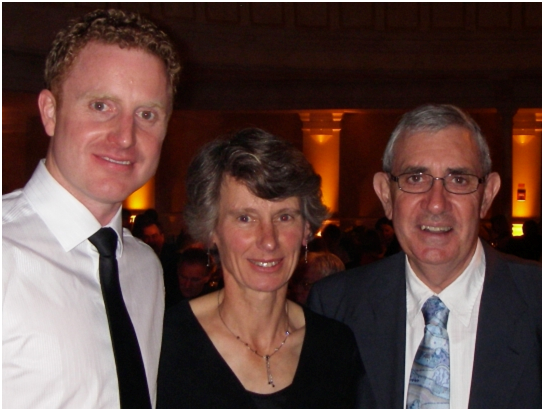
John Spencer, Head of School commented, "I was delighted to see Gillian recognised for her work as an inspirational science communicator, promoting science (and physics in particular) to students and the wider public through her talks, books and activities like the Science Fairs. Paul is also a great communicator, but this award recognises the enormous international and local impact his research has had in the field of magnetic resonance."
The Wellys had this to say about each of our finalists:
Sir Paul Callaghan is one of the most influential scientists in the country. He's a world-leader in nuclear magnetic resonance and nanotechnology — real science that's having a real impact on the world and New Zealand's place in it.
Dr Gillian Turner has inspired generations of young scientists through her work with science fairs, teaching, student advice and outreach at Victoria University. She has led the judging of the NIWA Wellington Fair since 2004. The publication of her popular science book, North Pole South Pole, further conveys her enormous capacity to captivate her audience, and to engender curiosity and lifelong learning.
Dr John Watt, the star of the TV Science show "Ever Wondered" has been named the top emerging scientist in the Prime Minister's science awards for his research into reducing vehicle exhaust pollution.
School awarded Marsden grants to support new research
7 October 2010
The School of Chemical and Physical Sciences was awarded three of the eight Marsden Fund grants received by the Faculty of Science.
Dr Justin Hodgkiss and Dr Natalie Plank each received Marsden Fast Start grants of $300,000 distributed over three years. Professor Sir Paul Callaghan was awarded the largest Marsden grant in New Zealand—$1.04 million—and Victoria's largest ever, for his research into nuclear magnetic resonance (NMR). Petrik Galvosas, a Post Doctoral Fellow in the School, is also a Principal Investigator in the NMR project.
Paul Callaghan's work will further develop the programme's advanced Rheo-NMR methods to study shear banding fluctuations in micellar, polymeric and soft glassy systems. Rheo-NMR gives information about molecular motion and organisation in systems out of equilibrium.
"There is wide scientific interest in such capability and part of this programme will involve building a prototype instrument for potential commercialisation," he says.
Dr Natalie Plank's project, How do ZnO nanowires measure up as biosensors? is involved with examining the factors that contribute to the lack of selectivity currently observed with the use of nanowires as lab-on-a-chip electronic biosensor devices.
A series of devices will be made to isolate each factor and build a selectivity profile — starting with single-nanowire devices that only expose specific parts of the device to specific types of analytes. The knowledge gained will then be applied to the development of nanowire biosensor devices that have both exceptional sensitivity and selectivity.
Justin Hodgkiss explains his project titled, Ultrafast electron dynamics in molecular semiconductors: "We will use exceptionally short laser pulses (only femtoseconds long) to capture snapshots of the 'electronic landscape' of organic semiconductors. Understanding how light absorption triggers the release of tightly bound electrons will guide the design of effective low-cost organic semiconductors for printable solar cells."
In addition, Dr Richard Tilley will assist Dr Liping Pang from ESR in a project titled: Micro-mimics: Mimicking virus removal and transport in groundwater using surface charge-modified, DNA-labelled silica nanobeads, worth $873,000.
Overall, Victoria researchers submitted a record 158 applications, 38 of which were invited to submit a full proposal, which then resulted in 15 projects being funded. That conversion rate of 9.5 percent was slightly higher than the national average of nine percent.
Honorary Doctorate for Professor Sir Paul Callaghan
21 September 2010
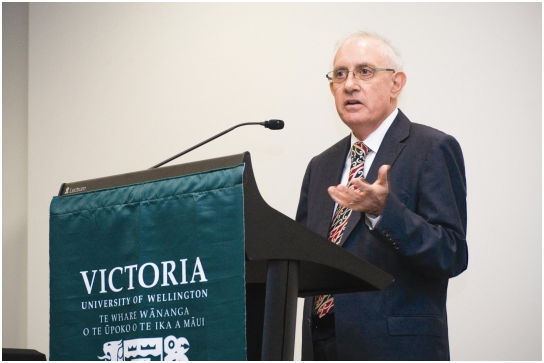
Victoria University will confer an honorary degree on distinguished physicist, Paul Callaghan.
Professor Sir Paul Callaghan is a world leader in the field of nuclear magnetic resonance and was founding director of the MacDiarmid Institute for Advanced Materials and Nanotechnology, based at Victoria University.
He is known nationally and internationally as a world class scientist and an inspired teacher of physics. In recent years, he has been at the forefront of connecting science and business—his 2009 book Wool to Weta put forward his vision of a future New Zealand economy based on
science, technology and intellectual property. His research into nuclear magnetic resonance and its applications led directly to the founding of Magritek Ltd, a Wellington based company, which supplies specialised scientific instruments worldwide.
Victoria University Vice Chancellor, Professor Pat Walsh, says that Professor Sir Callaghan has made an immense contribution to the country.
"In addition to his own prolific work and cutting edge research, he has made significant contributions to communicating science to the wider community and has added significantly to the debate about technology and its role in ensuring New Zealand's future prosperity."
In 2004, Professor Sir Callaghan was the first scientist outside of Europe to receive the prestigious Ampere Prize for research in magnetic resonance. Earlier this year, he won another major international award—the Günther Laukien Prize for Magnetic Resonance.
He received the Rutherford Medal in 2005, New Zealand's highest accolade for science, and in 2006 he was appointed a Principal Companion of the New Zealand Order of Merit, an honour which was redesignated as a knighthood last year.
Lung imaging experts share their knowledge
26 August 2010
Dr Galina Pavlovskaya and Prof Thomas Meersmann have been visiting the School of Chemical and Physical Sciences for the last three weeks. The husband and wife team were also here for a six month sabbatical in 2007.
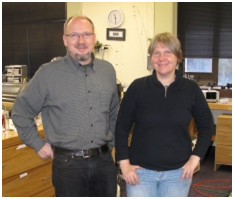
Supported by the MacDiarmid Institute and working with Prof Sir Paul Callaghan, they are collaborating in ongoing research to develop new and improved magnetic resonance techniques.
Their work at the University of Nottingham is involved with research into new 'functional imaging' techniques for medical applications. MRI imaging has revolutionised our view of the structure of the body, but is not sensitive enough to tackle functional imaging of the lungs for example, where the gas is observed during inhalation and exhalation. The technique could also be applied to other organs to view the processes in real time and identify regions of diseased tissue.
To enable nuclear resonance techniques to be useful for the analysis of gases, the gas can be hyperpolarised (the nuclear spins of the gas molecules aligned) using laser light, to increase its response. Spectacular results have been obtained in studies with 3He where rat lungs are imaged as they breathe in the hyperpolarised noble gas.
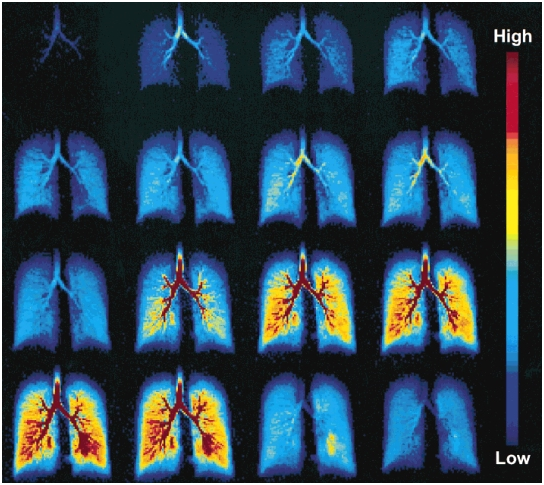
Time sequence of Helium-3 MRI of lungs during inhalation and exhalation. M Salerno TA Altes JR Brookemann EE de Lange JP Mugler III Magnetic Resonance in Medicine 46:667-677 (2001)
Work in the School has focussed on our novel porous materials. "They are surprisingly similar to lungs, though the gas tends to flow through the material rather than flowing in and out," Thomas says. Galina and Thomas have assembled a laser-irradiated gas chamber to hyperpolarise xenon gas before it passes into porous materials in an NMR spectrometer here.
"We have really enjoyed our time in New Zealand," says Galina. "We have obtained some good initial results and are pleased to be part of this exciting project and continue our work with Paul. He is a leader in the field."
Prestigious international award for eminent Victoria University scientist
16 April 2010
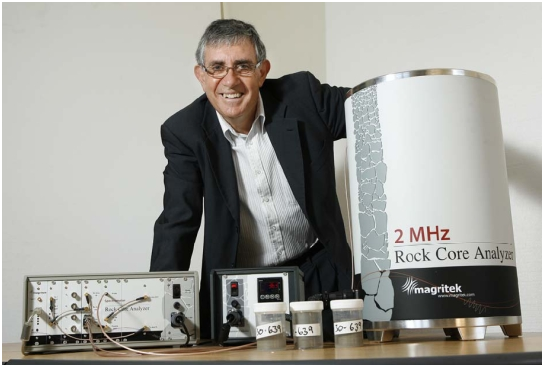
Innovative research resulting in millions of export earnings for New Zealand has landed School of Chemical and Physical Sciences physicist Professor Sir Paul Callaghan a major international award. "Blown away" was the reaction of Professor Callaghan on hearing he had won the prestigious Günther Laukien Prize for Magnetic Resonance.
The award is given for "cutting edge experimental nuclear magnetic resonance (NMR) research with a high probability of enabling beneficial new applications".
"My work in nuclear magnetic resonance essentially uses radio waves to detect the motion of molecules," says Professor Callaghan.
"The exciting thing is that we've now got a New Zealand company—Magritek—exporting NMR technology overseas. Although NMR technology probably doesn't mean a lot to most people, the young company has 16 employees and revenue in the millions.
"The way I see it, if the general public is familiar with the things being manufactured in the high tech sector, we're probably trying to produce the wrong things.
"New Zealand is not going to be making flat-screen TVs. Our future is in high tech, niche markets and that's how we'll ensure that the New Zealand we know and love is still here tomorrow."
The prize was announced on 19 April at the annual Experimental Nuclear Magnetic Resonance Conference at Florida in the United States. Unfortunately, Professor Callaghan was unable to receive the award in person because he is undergoing chemotherapy for cancer.
The prize was accepted on his behalf by a past PhD student, Dr Andrew Coy, now CEO of Magritek, a spin-out company from the MacDiarmid Institute for Advanced Materials and Nanotechnology based at Victoria University. Professor Callaghan was the Institute's founding Director.
"It's an honour to be included with previous winners who are some of the world's top people in the field," says Professor Callaghan.
The Vice-Chancellor of Victoria University, Professor Pat Walsh said that Professor Callaghan's award was well-earned.
"In recent years, his work has broadened to raise awareness on how to lift New Zealand's prosperity through research and technology. At heart though he remains a dedicated scientist and I am delighted that his illustrious career has been recognised in this way."
About the prize.
The Günther Laukien prize was established in 1999 to honour the memory of Professor Günther Laukien, the co-founder of Bruker Corporation. The prize is worth US $20,000.
It is awarded annually by a prize committee chaired by Nobel Laureate Professor Richard Ernst of the university, ETH Zürich.
Sir Paul Callaghan becomes Honorary Engineering Fellow
22 March 2010
Professor Sir Paul Callaghan has been elected an Honorary Fellow of the Institution of Professional Engineers of New Zealand (IPENZ) in recognition of his eminent contribution to application of engineering or technology in the community.
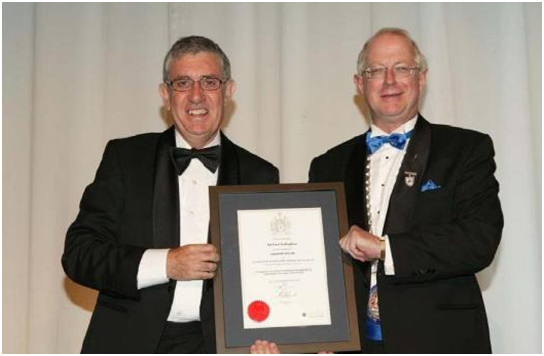
In its annual awards on Friday evening, IPENZ recognised his contribution for explaining to the public, business leaders and politicians the way in which engineering and science need to work together to create the high technology industries to increase New Zealand's prosperity.
Sir Paul has had an outstanding career in science; he was made a Fellow of the Royal Society of London and received the 2005 Rutherford Medal and the 2007 Blake Medal for leadership.
He is internationally recognised for his work in establishing the MacDiarmid Institute of Advanced Materials and Nanotechnology; however, it is Sir Paul's work in technology development that earned him the title of Honorary Fellow.
He played a fundamental role in leading the establishment of New Zealand's performance-based research funding system for tertiary institutions. In his book Wool to Weta: Transforming New Zealand's Culture and Economy, Sir Paul emphasises the need for engineering and science to work side by side and he has become a powerful advocate for the engineering, technology and science communities, through public presentations, and behind the scenes work with government.
"This Honorary Fellowship reflects the high esteem in which the engineering profession holds Sir Paul," says IPENZ Chief Executive, Andrew Cleland.
